![]() Call Us on 08081694454
Call Us on 08081694454
Patio Cleaning
Don’t you love a beautiful back garden and to compliment it – a clean patio showing all its glory of the quality stone you have chosen for your patio floor.
MOSS MONSTER too loves clean, attractive properties and happy customers. That’s why we SMASH away the dirt so it disappears, leaving you a bright and beautiful surroundings

Why do I need to clean my paving and patios?
It seems obvious but regular cleaning of your paving and patios is essential to maintaining their condition and ensuring they last as long as possible. Moisture and bacteria can cause moss and algae build ups which, while making your garden look tired and unkempt, can also make surfaces very slippery. Cleaning off the moss before it gets out of hand can help to prevent accidents. This also applies to deck surfaces.
Also, if left to their own devices, weeds can find their way in between the paving slabs and in areas you wouldn’t think were possible for them to grow. A regular clean will keep these at bay.

Pressure washers
This is a method that many have adopted as a quick way of cleaning paving and patios but should be used with extreme caution. Pressure washers work by blasting the surface with water and aggravating the dirt that lies on the paving to remove it. They can be very effective and when used correctly can keep your paving looking as good as new
Softwashing
Using the method of softwashing*, a stiff brush and steam cleaning we are able to optimise the cleaning process for a satisfactory and complete result. Steam cleaning works well in this process because it actually uses a low pressure but high temperature in contract to pressure washers with hot boxes which use high pressure and high temperature. When the latter technique is used then extreme caution needs to be applied so as to avoid blasting the mortar joints out inbetween the flagstones or patio stones. Care should be shown to the type of stone as to hardness and softness of the substrate.
*Softwashing is the application of low pressure agriculture type garden sprayers with a bio-degradable chemical mix of sodium hypochlorite, a surfactant and water.
How do I clean my patio?
One of the most common questions we get asked is “How do I clean my patio?” Unfortunately, there isn’t a single process for every stone type. Each natural stone differs due to its unique chemical composition and the products you clean it with can have a detrimental effect on the outcome if selected poorly. Location, time, traffic and the type of plants, shrubs and trees that are in close proximity will certainly affect how frequently your paving slabs require cleaning.
Cleaning and Maintaining Your Patio – Getting Started

As a rule, every patio should be swept to remove any debris before beginning the cleaning process. Next, warm, soapy water (pH neutral – NOT containing acid) and a stiff bristled brush can be used to scrub the stone – this method can be used on any natural paving stone, but make sure the bristles aren’t too stiff or even made of wire, as this can damage some of the smoother natural stones. A jet washer can be used but we would recommend having this on a low power setting and keeping a reasonable distance from the surface. Softer sandstone especially can loose their colour and vibrancy if power-washed too aggressively or too often.
Before using any product on paving, we recommend testing this on a small area to ensure it does not have a negative effect on your patio. Choose an area of the patio that doesn’t get much foot traffic, or even an off-cut from when the job was completed and test the new cleaning product. Give it a good coat of the product and let it sit for a couple of hours before washing off and checking if there has been any damage or change in the stone.
The most common forms of natural discolouration are moss, algae and lichens – so we will focus on how to best get rid of these on a variety of materials.
Cleaning Sandstone Paving Slabs – Do’s and Don’ts
The biggest thing to consider when cleaning sandstone is what has caused the discolouration and the porosity of the stone. If the stone is very porous, this requires a lot more attention.
Unsealed/untreated stone can be liable to more discolouration, especially soft sandstones such as Rainbow sandstone. To avoid this in future, once the patio has been cleaned the next time, it would be advisable to add a protective layer of sealant to stop any future discolouration. The hardier sandstones tend to deal with fade and discolouration a little better, so do not need sealing, but it is still an option to maintain that colour.
Cleaning Sandstone

Do’s:
Use a diluted bleach mixture. Sodium Hypochlorite is found in bleach and many other cleaning products and this is the component that kills most moss and algae. Use this with caution and be sure to test in on an inconspicuous area first to ensure it does not cause a reaction. Bleaching can lighten the colour of the paving, so please make sure you check first.
Follow the manufacturer’s guides when using any sandstone specific cleaning products.

Dont’s:
Do not use any cleaning product containing iron as this can react with the stone and could cause a rust colouration to the surface. A lot of products labelled as ‘Moss Killers’ contain the substance that can destroy moss well and truly, but can also discolour and rust your patio. The substance known as ‘Ferrous Sulphate’ can be called Iron for all intents and purposes should be avoided at all costs.
Cleaning Limestone Paving Slabs
Limestone can be challenging to remove stains as a lot of the common stain removers are not suitable for this material as they contain acid. This is because the geological make up of limestone contains a lot of calcium and other carbon-based material, which reacts terribly with acidic materials – completely ruining your stone.

Do’s:
If using a pH neutral detergent and water fails, a very mild bleach (100ml:4L of water) solution will be enough. Use this with caution and be sure to test in on an inconspicuous area first to ensure it does not cause a reaction. Bleaching can lighten the colour of the paving.
If a stronger stain or cement remover is required, it is imperative to check it is suitable for limestone (these are usually alkaline based, so perfectly suitable).

Dont’s:
Under no circumstances should an acid-based product be used on limestone paving, whether this be natural (lemon juice/vinegar) or man-made. The chemical reaction between the two can permanently discolour the surface.
Cleaning Slate Paving Slabs
Generally, slate is very robust and maintains its colours much better than a sandstone or limestone patio, so it should clean up much better. Simply follow the instructions at the top of the article and you should see good results each time you do it.
Once your slate has been installed, it is important to give it a good pressure wash as the layered characteristics of slate mean the top surface can flake. A higher quality slate will stabilise and stop flaking after the first few washes.
Cleaning Slate

Do’s:
Use a floor cleaner (pH Neutral) and water only.
Use a specialist slate cleaning product.
For tougher stains you can use a very mild bleach (100ml:4 litres of water) solution.

Dont’s:
Use a wire brush as slate can be susceptible to scratching.
Cleaning Granite Paving Slabs
Granite is naturally a highly durable material for paving, but it can still be affected by weathering and usage.
Overall granite is going to survive brutal weather and conditions without much of an issue, but it is important to give it a spruce up every now and again.
Cleaning Granite

Do’s:
Use a pressure washer. Often, it’s just the surface that requires dirt removing.
Use specific solutions formulated for use on stains with granite.

Dont’s:
Do not use an acid-based solution.
Do not use bleach.
1. Black infestation of algae on the yellow sandstone slabs.
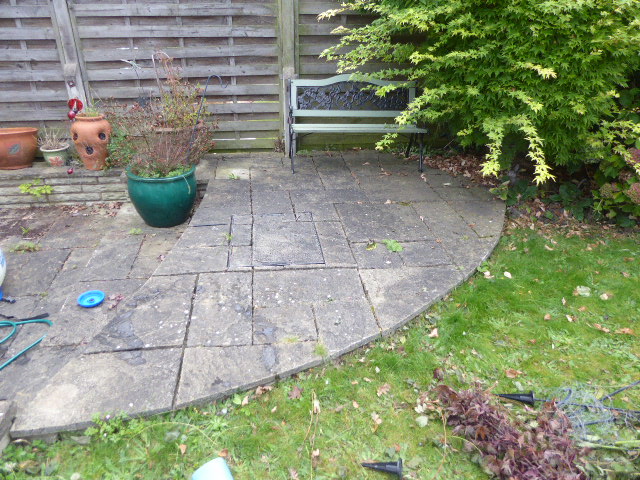
2. Pre-treatment with a biocide in order to break down the filament roots and loosen the grip of the algae and mould on the sandstone slabs. Plastic sheeting is used to cover the grass along with copious amounts of pre-drenching of water. Protecting grass and precious plants.
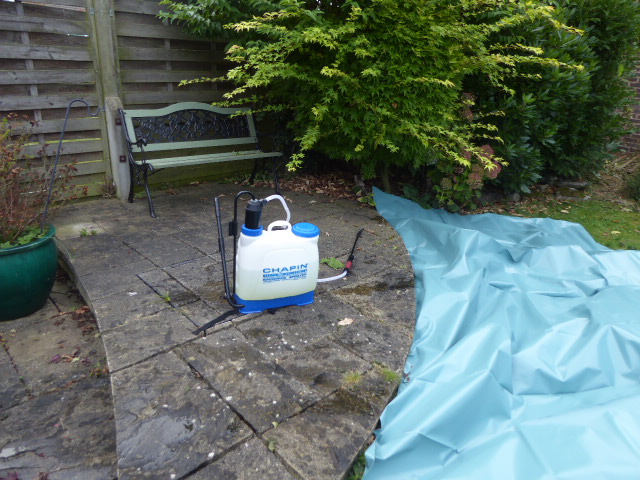
3. Allow time for the biocide to work (The biocide reacts causing a white bubbling on the surface)
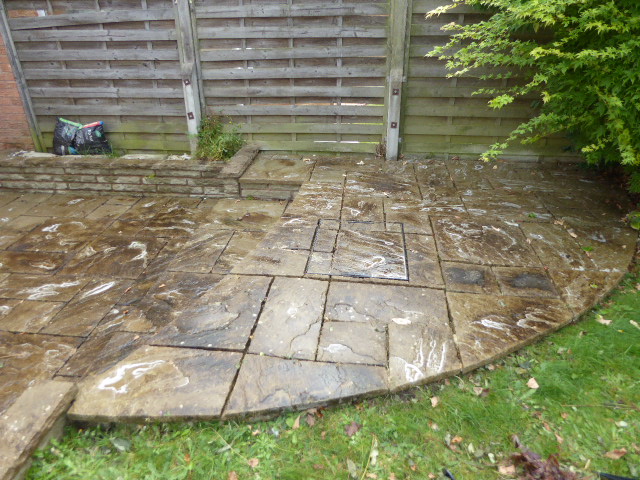
4. Hot steam Pressure washing to remove the killed algae.
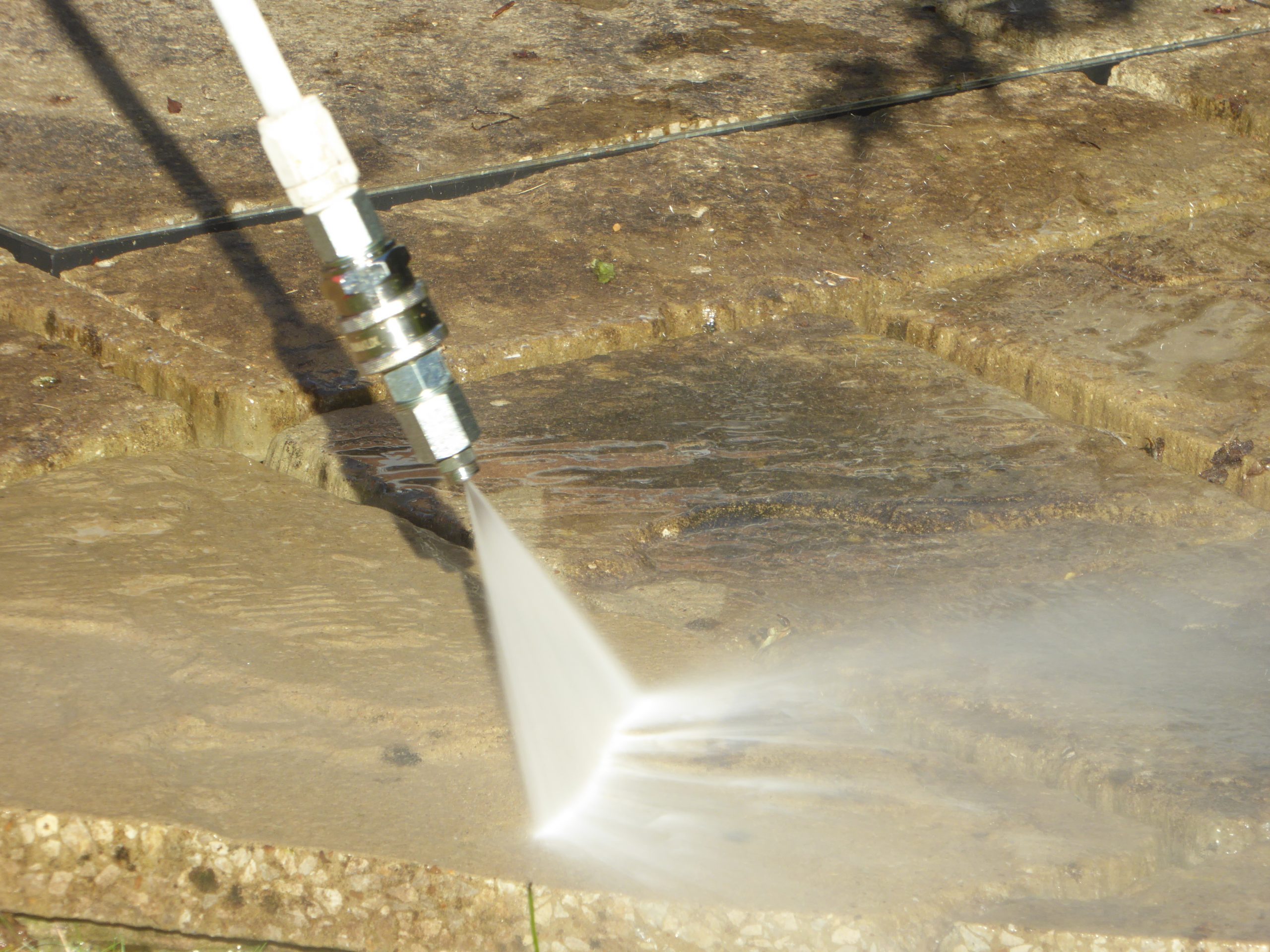
5. More attention to detail and more time to carefully assess the stubborn black spot which can often remain. More time needs to be spent on these particular areas.
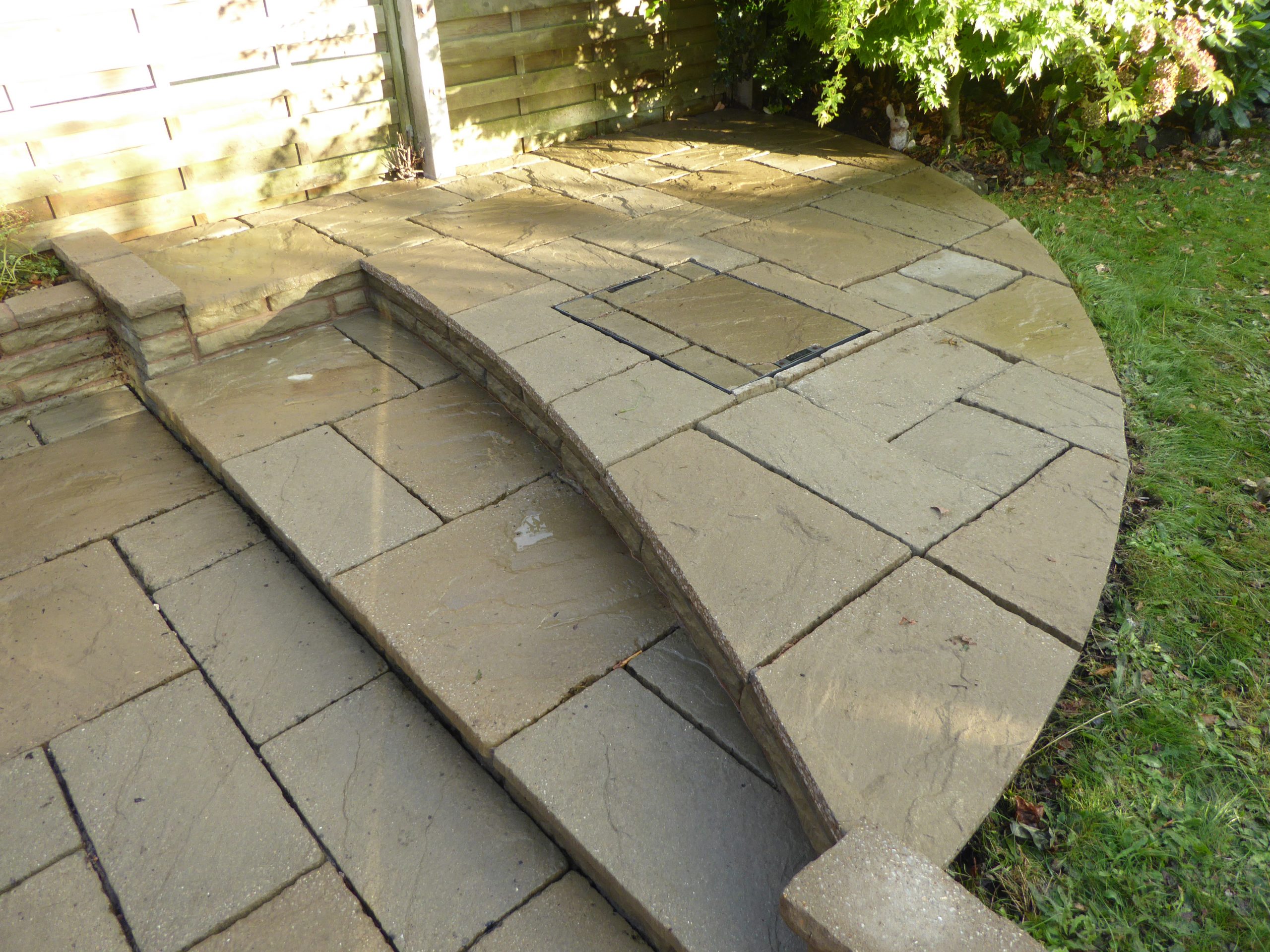
Sealing Your Paving Slabs – Additional Information
It is imperative when using chemicals that you wear your recommended protective clothing such as gloves, goggles, boots and overalls.
Prevention is certainly better than cure so by sealing your stone and regularly sweeping your patio will help reduce the chance of any debris staining the patio.
It’s important to note that there is no ultimate prevention for keeping your patio clean – if you ever discovered one, you could make millions! There are ways to keep on top of it, but as with any outdoor activity it’s going to get messy eventually.
When cleaning or maintaining your patio, there are so many options for cleaning products, but the important thing to do is test, test, test! Most are suitable for use on most types of paving, but it’s important to read labels and test a small are before committing to using it across the entire patio. The last thing you want to do is ruin your patio for good – so exercising a little caution goes a long way.
Should you Seal Stone Paving? (Including Indian Sandstone)
Stone Sealer – How important is sealing natural stone paving?
You’ve just had your ideal patio laid – but do you need to seal it? There are various reports all over the web about the benefits and drawbacks of sealing natural stone. Some suppliers insist it is necessary, others claim it ruins the stone for good. But what is the correct answer – and do you actually need to seal your stone?
The short answer: No.
The long answer: Natural stone has survived for 1000’s of years without any chemical treatments, so it’s unlikely to fall to pieces without a layer of sealant that some suppliers insist it needs. But there are benefits of doing so.
Lets dig down into the nitty-gritty of it and hopefully you can draw your own conclusions on whether to seal your new patio.
What is sealing and why would a patio need it?
Natural stone sealer is a product designed to protect stone from the elements and maintain its appearance. We all know the joys of British weather and your patio sits outside taking the brunt of it all year round. With the battering it takes, it has to be expected that it will change in appearance as the years go by. Sealing the stone is designed to slow down, or even halt the deterioration of the stone so that it looks newer for longer.


The protection not only acts as a barrier to bad weather, it’s also designed to protect against stains and spills. If a spillage sits on natural stone for any length of time, natural stone is liable to absorb this spillage causing permanent irreparable damage to the surface. Not ideal!
There are two types of sealer generally on the market:
Invisible Sealants – protects the stone without affecting appearance.
Colour Enhancers – These types of sealer generally darken to stone as well as protecting it.
Both options are equally viable, it simply depends on the desired effect.

Your New Patio Looks Amazing – Now What?
So you’ve spent a lot of money on your new outdoor space. It looks amazing and you want to make sure it stays this way. If you’ve used natural stone, there is a good chance it was one of the following materials:
Sandstone – Likely Indian Sandstone
Limestone – Black Limestone, Blue or Yellow
Slate – Brazilian slate or Riven Slate
Granite
Each of these materials are very different and need to be approached differently. If you are being told to seal the stone in the same way regardless of material, this is simply bad advice. The way you approach sealing or not sealing your new patio is incredibly dependent on the material it is constructed from. So let’s examine each of these in turn.

Should You Seal Indian Sandstone Paving?
This is the most common material found in patio projects across the UK. It’s widely available from a lot of suppliers and very simple to install.
Sandstone is what is known as a sedimentary stone. These types of stone have been formed out of fine grains forced together under intense pressure. Imagine sand on the sea floor crushed under the weight of water, or 1000s of years of desert sand building up and forcing the sand at the bottom to fuse together. These processes are what create sandstone.
So the stone itself has been through a lot! It’s robust and resistant to elements and as a result it ages very well. All natural stone is likely to fade over the years, but sandstone does this slowly and gracefully. Once it is laid, if you let it do its own thing then you will not have many problems at all.

So, do you need to seal sandstone paving?
The answer isn’t a definitive yes or no. Sandstone ages naturally – you won’t come home from work one day to find your sandstone patio has completely changed colour, so sealing isn’t necessarily required to protect the colours. It will stand up to the test no questions asked. So if you are happy to see your stone age naturally, which is often part of the charm for natural stone, then don’t worry about sealing it.
However there is one point to consider – sandstone is incredibly porous. This means that it is very quick to absorb stains which end up near-impossible to remove without some industrial grade cleaners. For many, this isn’t an issue. A few stains down the years are to be expected. But by sealing sandstone, you can ensure that any stains that do occur (think bird droppings which are unavoidable!) are easier to remove with simple soapy water or a power washer.
So, should you seal it? – Only if you are worried about stains. Otherwise let it do its thing!
Should You Seal Limestone Paving?
Whilst Limestone behaves similarly to sandstone when it is being laid, the chemical make up of Limestone is very different. It ages differently and weathers differently to sandstone, so needs to be treated differently.
Both Sandstone and Limestone are made up of grains which have been fused together by pressure, however there are differences in what these grains are made from. Sandstone consists mainly of silicon based grains which are often made of up other rocks or other single element minerals, whereas Limestone is often made from skeletal fragments and other calcium based elements. As a result the two behave very differently when exposed to the elements.
Limestone, no matter the colour, is much more susceptible to fading and sun-bleaching as soon as it is in constant contact with UV light. This is especially noticeable if it is Black Limestone, but other colours such as Kota Blue (above) are also liable to fade in the sunlight. Because the makeup of the Limestone is often calcium based, it is much more affected by the weather than anything made from silicon.
So, do you need to seal limestone paving?
You never need to seal your stone, but with limestone it is highly advisable. When compared to other stone types, Limestone fares much worse than others due its chemical make up being largely carbon based.
However, if you are interested in a natural look you won’t ruin to stone if you leave it unsealed. But the colour of your limestone will change relatively quickly and will stop looking brand new after a few months if left untreated.
So, should you seal it? – Ideally yes. If you want to maintain the new-ish look for as long as possible, both a colour enhancing sealer or an invisible sealer will do wonders for it.

Should You Seal Slate Paving Slabs?
Slate is an incredibly decorative stone. You often pay extra money for it because it looks so spectacular. But does it need sealing?
Slate slabs are different to limestone & sandstone slabs as they are a metamorphic rather than sedimentary. Without getting too technical, the minerals that form slate have been forced together by horizontal tectonic forces which make the slate form in sheets/layers. Initially, the stone is not dissimilar to a sedimentary stone, but the tectonic forces have been acting on them for years forcing them together into layers. This means the stone is stronger than both sandstone and limestone and therefore less vulnerable to the elements.
If you did want more technical information, you can find it here: https://geology.com/rocks/slate.shtml

So, do you need to seal slate paving?
As the stone is much stronger than the previous stones discussed, the answer is no. Slate does not need sealing for its own protection. It handles the sunlight, UV rays and rain very well, and should stay looking new for much longer. So it isn’t necessary.
However, slate is often purchased for it’s beauty. It is a naturally glossy product as you can see above. When wet, the slate really shines and produces an amazing effect. If you wanted to maintain this beautiful effect, a colour enhancing sealer is perfect.
So, should you seal it? – It’s not required. But it is really suited to a colour enhancing treatment.
Should You Seal Granite Paving Slabs?
Granite – the hardest natural stone on the market. Formed from volcanic rock, the texture patterns are unlike anything else out there.
This is the easiest natural stone to answer for. Granite is cooled volcanic rock for goodness sake! It is all but impervious to the effects of ageing and fade.
So, do you need to seal granite paving?
Not at all. It retains very little water, remains unaffected by the elements and it’s colour will remain for years. There is simply no need to seal it.
So, should you seal it? No.

“Applying best techniques in this industry”

Limited Company Information:
Company Number: 13463041
Registered Business Office Address:
Wootton Taylor,
30 Foregate Street
Worcester
WR1 1DS
Registered in England & Wales
VAT NO. 458 0834 72
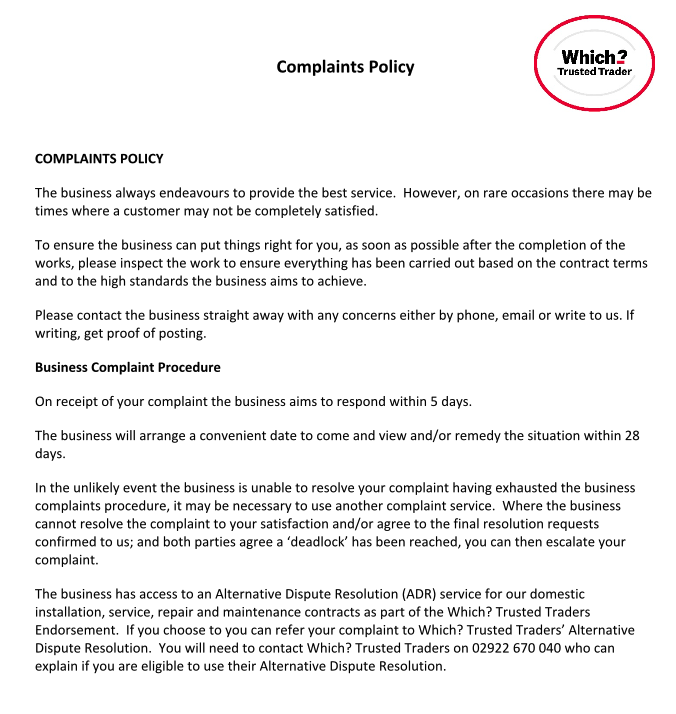
Disclaimer:
The information provided here is for general informational purposes only and should not be considered as specific professional advice.
While efforts are made to ensure the accuracy and completeness of the content, no responsibility is taken for any consequences that may arise from the personal use of this information. It is always recommended to seek our professional advice and conduct thorough research tailored to your specific situation before making any decisions. The user assumes all responsibility and risk for the use of the information provided.



